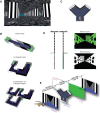Virtual reality systems for rodents
- PMID: 29491968
- PMCID: PMC5804145
- DOI: 10.1093/cz/zow070
Virtual reality systems for rodents
Abstract
Over the last decade virtual reality (VR) setups for rodents have been developed and utilized to investigate the neural foundations of behavior. Such VR systems became very popular since they allow the use of state-of-the-art techniques to measure neural activity in behaving rodents that cannot be easily used with classical behavior setups. Here, we provide an overview of rodent VR technologies and review recent results from related research. We discuss commonalities and differences as well as merits and issues of different approaches. A special focus is given to experimental (behavioral) paradigms in use. Finally we comment on possible use cases that may further exploit the potential of VR in rodent research and hence inspire future studies.
Keywords: behavioral neuroscience; closed loop; multisensory stimulation; neural coding; sensorimotor integration; spatial navigation..
Figures



References
-
- Acharya L, Aghajan ZM, Vuong C, Moore JJ, Mehta MR, 2016. Causal influence of visual cues on hippocampal directional selectivity. Cell 164:197–207. - PubMed
-
- Aghajan ZM, Acharya L, Moore JJ, Cushman JD, Vuong C. et al., 2015. Impaired spatial selectivity and intact phase precession in two–dimensional virtual reality. Nat Neurosci 18:121–128. - PubMed
-
- Ayaz A, Stäuble A, Helmchen F, 2014. A virtual tactile environment to study somatosensory processing in mouse cortex during locomotion. 9th FENS Forum of Neuroscience; 2014 Jul 5–9; Milan, Italy. Available from: http://fens2014.meetingxpert.net/FENS_427/poster_101150/program.aspx.
LinkOut - more resources
Full Text Sources
Other Literature Sources
